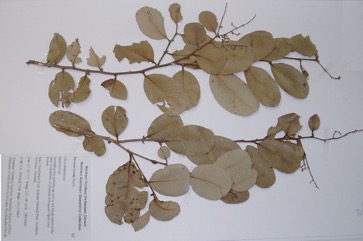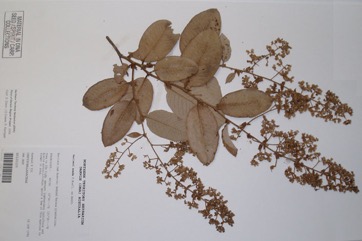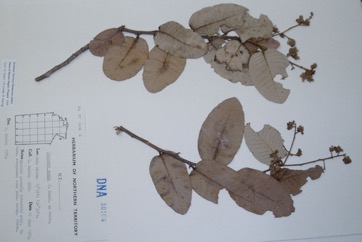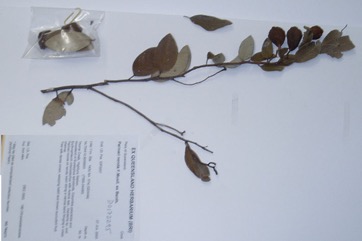Nonda plum, Solomon Islands parinari

A tropical plant. The tree grows in lowland areas from 6 to 1300 m altitude in Papua New Guinea. It occurs in moist rainforest and open woodland. It is often in dunes behind sandy beaches. It occurs in northern Australia. It suits seaside dry tropical regions. It can tolerate drought. It needs full sun.
Also known as:
Nunda, Parinari, Weiba
Synonyms
- Ferolia nonda (F. Muell. ex Benth.) Kuntze
- Parinarium nonda F. Muell.
- Parinari papuanum CT White
- - now a recognised species.
Edible Portion
- Fruit, kernel, Nuts
Where does Nonda plum grow?
Found in: Australia, Pacific, Papua New Guinea, PNG, Solomon Islands, Torres Strait
Notes: There are about 50 Parinari species. They grow in the tropics.
Status: A minor edible wild fruit. The "nut-milk" was especially used for babies.
Growing Nonda plum, Solomon Islands parinari
Cultivation: The tree grows wild. They can be grown from fresh seed. It can probably be grown from cuttings of semi ripe wood.
Edible Uses: The ripe fruit is eaten raw. The floury pulp of the fruit can be ground into flour and baked.
Production: it is slow growing. Fruit occur in August and November (May). Fruit are bitter when fresh from the tree so are best ripened off the tree to make them more sweet. Burying them for a week has been used to improve ripening. They can be harvested after they fall. To make nut-milk the fruit was dried and the kernels crushed and the mash was washed, squeezed and strained to extract the white "nut-milk".
Nutrition Info
per 100g edible portion| Edible Part | Energy (kcal) | Protein (g) | Iron (mg) | Vitamin A (ug) | Vitamin c (mg) | Zinc (mg) | % Water |
|---|---|---|---|---|---|---|---|
| Fruit | 53 | 1 | 1.5 | - | 1 | 0.4 | 78.3 |
Nonda plum, Solomon Islands parinari Photos




References
Barwick, M., 2004, Tropical and Subtropical Trees. A Worldwide Encyclopedic Guide. Thames and Hudson p 309
Bindon, P., 1996, Useful Bush Plants. Western Australian Museum. p 194
Boland, D. J. et al, , 2006, Forest Trees of Australia. CSIRO p 86
Cooper, W. and Cooper, W., 2004, Fruits of the Australian Tropical Rainforest. Nokomis Editions, Victoria, Australia. p 121
Cribb, A.B. & J.W., 1976, Wild Food in Australia, Fontana. p 48
Doran, J.C., & Turnbull, J.W. (Eds), 1997, Australian Trees and Shrubs: species for land rehabilitation and farm plantings in the tropics. ACIAR Monograph No 24. p 332
Elliot, W.R., & Jones, D.L., 1997, Encyclopedia of Australian Plants suitable for cultivation. Vol 7. Lothian. p 166 (Photo)
Fell, D.G. & Stanton, D.J., 2015: The vegetation and flora of Mabuyag, Torres Strait, Queensland. Memoirs of the Queensland Museum – Culture 8(1):1-33. Brisbane. ISSN 1440-4788
French, B.R., 1986, Food Plants of Papua New Guinea, A Compendium. Asia Pacific Science Foundation p 298
French, B.R., 2010, Food Plants of Solomon Islands. A Compendium. Food Plants International Inc. p 359
Hedrick, U.P., 1919, (Ed.), Sturtevant's edible plants of the world. p 464
Hiddins, L., 1999, Explore Wild Australia with the Bush Tucker Man. Penguin Books/ABC Books. p 155
Isaacs, J., 1987, Bush Food, Aboriginal Food and Herbal Medicine. Weldons. p 77
Jones D, L, 1986, Ornamental Rainforest Plants in Australia, Reed Books, p 340
Kenneally, K.E., Edinger, D. C., and Willing T., 1996, Broome and Beyond, Plants and People of the Dampier Peninsula, Kimberley, Western Australia. Department of Conservation and Land Management. p 86
Milson. J., 2000, Trees and Shrubs of north-west Queensland. DPI p 44
Mua Bioversity Profile, 2013, Profile for Management of the Habitats and Related Ecological and Cultural Resources of Mua Island. Torres Strait Regional Authority Land & Sea Management Unit. p 32
Paczkowska, G. & Chapman, A.R., 2000, The Western Australian Flora. A Descriptive Catalogue. Western Australian Herbarium. p 215
Scarth-Johnson, V., 2000, National Treasures. Flowering Plants of Cooktown and Northern Australia. Vera Scarth-Johnson Gallery Association. Cooktown, Australia. p 46
Wheeler, J.R.(ed.), 1992, Flora of the Kimberley Region. CALM, Western Australian Herbarium, p 281
World Checklist of Useful Plant Species 2020. Royal Botanic Gardens, Kew